
Ch 1: Foundations of Environmental Systems and Societies
1.1 - Environmental value systems
Environmental value system (EVS): a worldview that shapes the way an individual or group perceive and evaluate environmental issues
Examples: culture, religion, economic and socio-political context
Who is included in the environmental movement?
Influential individuals: often use social media to raise awareness
Independent pressure groups: they use awareness campaigns to make a change. They influence the government and corporate business organisations → Non Governmental Organisations (NGO’s)
Corporate businesses: multinational corporations (MNC) and transnational corporations supply consumer demand and create environmental impact
mining for minerals or burning of fossil fuels
Governments: make policy decisions which include environmental ounces, such as planning permission for land use, applying legislation to manage emissions controls over factories
Intergovernmental bodies: these groups hold summits about earth to bring governments, NGOs and corporations to consider environmental and world development issues
Categories of EVS:
Ecocentric worldview: puts ecology and nature as central to humanity (less materialistic lifestyle)
Deep ecologists
Soft reliant, soft ecologists
Anthropocentric: believes humans must sustainably manage the global system
Humans are not dependent on nature but nature is there to benefit from mankind
Technocentric: believes that technological developments can provide solutions to environmental problems
Environmental managers → technocentrists
Extreme technocentrists → cornucopians
Cornucopians: people who see the world as having infinite resources to benefit humanity. They think that technology can solve any problem
Environmental managers: believe that we have an ethical duty to protect and nurture the earth
Biocentric: thinkers see all life as shaving value for its own sake, not just for humans. Humans should not cause premature extinction of any species
the ultimate source of energy for all organisms → sun
Deep ecologists: put more value on nature than humanity. They believe in biologists, universal rights where all species and ecosystems have value and humans cannot interfere with it
1.2 - Systems and Models
System: set of interrelated parts working together to make a complex whole, can be living or nonliving. Systems are all more than the sum of their parts
Can exist in many scales (large or small)
Can be open, closed, or isolated, though most systems are open
Material and energy undergo transfers and transformations in flowing from one storage to the next
Biosphere = atmosphere + lithosphere + hydrosphere + ecosphere
Systems can be closed, open, or isolated
Biome: can be seen as an ecosystem. It helps if the ecosystem has clear boundaries
Biosphere: is a fragile skin on planet earth. Includes atmosphere (air), lithosphere (rocks), hydrosphere (water)
All systems have:
Systems (stores of matter/energy)
Flows (into, through, and out of the system)
Inputs
Outputs
Boundaries
Processes (which transfer or transform energy or matter from storage to storage)
Matter (material) and energy flow through ecosystems as:
Transfers: when energy or matter flows and changes location but does not change its state
Movement of material → in a non-living process
The movement of energy
Movement of material through living organisms
Transformations: when energy or matter flow and changes its state, a change in the chemical nature, a change in state or energy
Matter to matter
Matter to energy
Energy to energy
Transfers require less energy → more efficient than transformations
An open system exchanges matter and energy with their environments; all ecosystems are open systems
Examples: in forest ecosystems:
Plants fix energy from light energy entering the system during photosynthesis
Nitrogen from the air is fixed by soil bacteria
Water is lost through evaporation and transpiration from plants
A closed system exchanges energy (not matter) with its environment. They are extremely rare in nature
Light energy enters the earth’s ecosystem in large amounts and some is eventually returned to space as long-wave energy (heat). This is how a closed system operates.
An isolated system neither exchanges matter nor energy with its environment. They do not naturally exist; the entire universe is an isolated system.
Models are simplified versions of systems, it could be:
A physical model (a wind tunnel)
A software model (climate change or evolution)
Mathematical diagrams
Data flow diagrams
Advantages of Models:
Easier to work with than complex reality
Used to predict the effect of a change of input
Can be applied to other situations
Used to visualise small and large things
Can help us observe patterns
Disadvantages of models:
Predictions may be inaccurate
Accuracy is lost
Model will be wrong if our assumptions are wrong
Sustainability is achieved only when economy, society, and the environment overlap
1.3 - Energy and Equilibrium
First law of thermodynamics: principle of conservation of energy
Principle of conservation of energy: states that energy in isolated systems can be transformed but not created or destroyed
Second law of thermodynamics: states that energy is transformed through energy transfers
Entropy: a measure of the amount of disorder in a system
Refers to the spreading out of dispersal of energy
More energy = less order
When entropy is used to do work, some energy is always wasted as heat energy
Energy = work + heat (+other wasted energy)
Efficiency: the useful energy, the work or output produced by a process divided by the amount of energy consumed being the input to the the process
Efficiency = work or energy produced / energy consumed
Efficiency = useful output / input
TIP: multiply by 100% if you need the answer in a percentage
Equilibrium: the tendency of the system to return to an original state following disturbance. At an equilibrium; a state of balance exists among the components of a system
Types of Equilibrium: static, steady state, stable, unstable
Steady-state equilibrium: a characteristic of an open system where there are continents inputs and outputs of energy and matter, the system remains in constant state
No long-term changes, however, small fluctuations occur in the short term
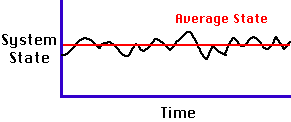
Static equilibrium: no change occurs over time. Most non-living systems are in a state of static equilibrium
This cannot occur in a living system, it can only occur in an isolated system
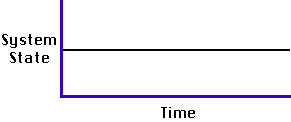
Stable equilibrium: the system tends to return to the same equilibrium after a disturbance
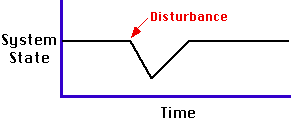
Unstable equilibrium: the system will return to a new equilibrium after a disturbance
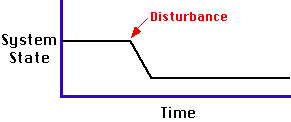
Feedback loop: when information that starts as a reaction in turn may input more information which may start another reaction
This is a way that the input is affected by the output. In a stable equilibrium, feedback returns the equilibrium to its original state.
In an unstable equilibrium, feedback returns the equilibrium to a different state
Negative feedback loop: stabilises steady state equilibria, occur when the output of a process inhibits or reverses the operation of the same process in such a way to reduce change, counteracts deviation.
Returns back to its original state
Stabilising as they reduce change
Positive feedback loop: will amplify changes and bring the system towards a new tipping point where a new equilibrium is adopted
Change a system to a new state
Destabilising as they increase change
Albedo: reflecting ability of a surface
Resilience: the ability of a system to return to its initial state after a disturbance
If a system has low resilience it will enter a new state
Generally considered a good thing, for example, bacterium will not be affected from antibiotics which is not good
Factors affecting ecosystem resilience:
Biodiversity increases resilience
Species that can shift their geographical range → more resilient
Fast reproductive rate means faster recovery
An ecological tipping point: is a reached when an ecosystem experiences a shift to a new state
Significant changes occur in biodiversity and services it provides
Changes are long lasting and hard to reverse
Lake eutrophication: nutrients added to a lake may not change much until enough nutrients are added to change its state
Occurs when bodies of water are overly enriched with minerals and nutrients which promotes the growth of algae
Extinction of a keystone species: A keystone species within an ecosystem is fundamental to keeping the ecosystem stable and supported
Their extinction can negatively affect the ecosystem
Coral reef death: if ocean acidity rises enough the reef coral dies and cannot regenerate
1.4 - sustainability
Sustainability: the use of resources that allows full natural replacement of the resources used and full recovery of the ecosystems affected by their extraction
Sustainable development: development that meets the needs of the present without compromising the ability of future generations to meet their own needs
Ecological overshoot: when a sustainable resource is exploited to its maximum
Replenishing the resources will take longer
This increased demand is due to level of overall consumption, per capita consumption
Natural capital: natural resources that can produce a sustainable natural income of goods or services
Economics use the world “capital” ro describe the means of production. For example: Factories, tools, machines…
Used to create goods which provide income
Environmental impact assessments (EIA): is a report prepared before a development project changes the use of lans. It weighs up the advantages and disadvantages of the development
Will qualify changes to microclimate, biodiversity, scenic and amenity value resulting from the changes
These measurements represent the “baseline study”
Baseline study: an analysis of a current situation to identify the starting points for a project
Ecological footprint (EF): the area of land and water required to sustainability provide all resources at the rate which they are being consumed by a given population
A model used to estimate the demands that human populations place on the environmental
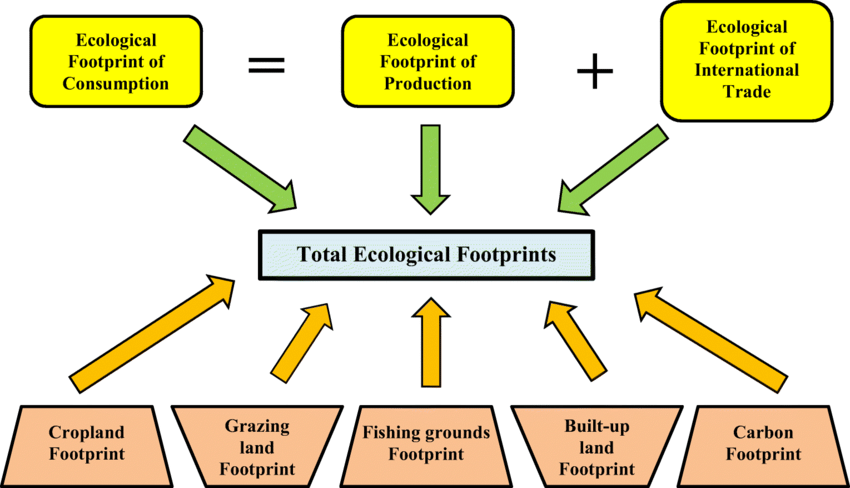
1.5 - Humans and Pollution
Pollution: the introduction/addition of a substance to the environment by human activity. This addition is considered harmful to the environment
Pollutants released by human activities: matter, energy, living organisms
Matter (gasses, liquids, solids) which is organic (contains carbon atoms) or inorganic
Energy (sound, light, heat)
Living organisms
Primary pollutants: are active on emission (carbon monoxide) from the incomplete combustion of fossil fuels
Causes headaches, fatigue, and can kill
Secondary pollutants: are formed by primary pollutants undergoing physical or chemical changes
Point source and nonpoint source pollutants:
Nonpoint course (NPS):
Release of pollutants from dispersed origins, example: exhaust gases from vehicles
Has many sources (hard to detect its origin)
Rainwater can collect nitrates which are used as fertilisers
Air pollution can be blown and mix with other chemicals
Point source (PS):
Release of pollutants from a single site
Easier to locate pollution
Easier to manage and can be found more easily
Persistent organic pollutant (POPs): a toxic environmental contaminant which requires special handling and disposal
Resistant to breaking down and remain active in the environment for a long time
Can cause significant harm, Health wise, due to the heavy pollution we are inhaling
High molecular weight
Not soluble in water
Highly soluble in fats and liquids (can pass through cell membranes)
Biodegradable pollutants: do not persist in the environment and break down quickly. May be broken down by decomposer organisms or physical processes. Example: Light, heat
Acute pollution: when large amounts of pollutants are released causing a lot of harm
Chronic pollution: long term release of a pollutant but in small amounts
Often goes undetected for a long time
More difficult to clean up
Often spreads widely
Pollution:
Direct measurements of air pollution:
acidity of rainwater
amount of gas in the atmosphere
amount of particles emitted by a diesel engine
amount of lead in the atmosphere
Direct measurements of water or soil pollution:
nitrates and phosphates
amount of organic matter or bacteria
heavy metal concentrations
Indirect measurements of pollution:
Measuring abiotic factors that change as a result of the pollutant (oxygen content of water)
Recording the presence of indicator species, only found if the water is polluted or unpolluted
How can pollution be managed?
By changing the human activity which produced it
By working to restore or clean up damaged ecosystems
By regulating or preventing the release of the pollutant
Human activity: promoting alternative technologies through
Controlling release of pollutant/release of pollutant into environment
Impact of pollution on ecosystems
Campaigns, education, community groups, governmental legislation, economic incentives/disincentives
Controlling release of pollutant/release of pollutant into environment:
Legislating and regulating standards of emission
Developing/applying technologies for extracting pollutant from emissions
Impact of pollutant on ecosystems: Clean up and restoration of damaged systems:
Extracting and restoration of damaged systems
Replanting/restocking lost or depleted populations and communities
Ch 1: Foundations of Environmental Systems and Societies
1.1 - Environmental value systems
Environmental value system (EVS): a worldview that shapes the way an individual or group perceive and evaluate environmental issues
Examples: culture, religion, economic and socio-political context
Who is included in the environmental movement?
Influential individuals: often use social media to raise awareness
Independent pressure groups: they use awareness campaigns to make a change. They influence the government and corporate business organisations → Non Governmental Organisations (NGO’s)
Corporate businesses: multinational corporations (MNC) and transnational corporations supply consumer demand and create environmental impact
mining for minerals or burning of fossil fuels
Governments: make policy decisions which include environmental ounces, such as planning permission for land use, applying legislation to manage emissions controls over factories
Intergovernmental bodies: these groups hold summits about earth to bring governments, NGOs and corporations to consider environmental and world development issues
Categories of EVS:
Ecocentric worldview: puts ecology and nature as central to humanity (less materialistic lifestyle)
Deep ecologists
Soft reliant, soft ecologists
Anthropocentric: believes humans must sustainably manage the global system
Humans are not dependent on nature but nature is there to benefit from mankind
Technocentric: believes that technological developments can provide solutions to environmental problems
Environmental managers → technocentrists
Extreme technocentrists → cornucopians
Cornucopians: people who see the world as having infinite resources to benefit humanity. They think that technology can solve any problem
Environmental managers: believe that we have an ethical duty to protect and nurture the earth
Biocentric: thinkers see all life as shaving value for its own sake, not just for humans. Humans should not cause premature extinction of any species
the ultimate source of energy for all organisms → sun
Deep ecologists: put more value on nature than humanity. They believe in biologists, universal rights where all species and ecosystems have value and humans cannot interfere with it
1.2 - Systems and Models
System: set of interrelated parts working together to make a complex whole, can be living or nonliving. Systems are all more than the sum of their parts
Can exist in many scales (large or small)
Can be open, closed, or isolated, though most systems are open
Material and energy undergo transfers and transformations in flowing from one storage to the next
Biosphere = atmosphere + lithosphere + hydrosphere + ecosphere
Systems can be closed, open, or isolated
Biome: can be seen as an ecosystem. It helps if the ecosystem has clear boundaries
Biosphere: is a fragile skin on planet earth. Includes atmosphere (air), lithosphere (rocks), hydrosphere (water)
All systems have:
Systems (stores of matter/energy)
Flows (into, through, and out of the system)
Inputs
Outputs
Boundaries
Processes (which transfer or transform energy or matter from storage to storage)
Matter (material) and energy flow through ecosystems as:
Transfers: when energy or matter flows and changes location but does not change its state
Movement of material → in a non-living process
The movement of energy
Movement of material through living organisms
Transformations: when energy or matter flow and changes its state, a change in the chemical nature, a change in state or energy
Matter to matter
Matter to energy
Energy to energy
Transfers require less energy → more efficient than transformations
An open system exchanges matter and energy with their environments; all ecosystems are open systems
Examples: in forest ecosystems:
Plants fix energy from light energy entering the system during photosynthesis
Nitrogen from the air is fixed by soil bacteria
Water is lost through evaporation and transpiration from plants
A closed system exchanges energy (not matter) with its environment. They are extremely rare in nature
Light energy enters the earth’s ecosystem in large amounts and some is eventually returned to space as long-wave energy (heat). This is how a closed system operates.
An isolated system neither exchanges matter nor energy with its environment. They do not naturally exist; the entire universe is an isolated system.
Models are simplified versions of systems, it could be:
A physical model (a wind tunnel)
A software model (climate change or evolution)
Mathematical diagrams
Data flow diagrams
Advantages of Models:
Easier to work with than complex reality
Used to predict the effect of a change of input
Can be applied to other situations
Used to visualise small and large things
Can help us observe patterns
Disadvantages of models:
Predictions may be inaccurate
Accuracy is lost
Model will be wrong if our assumptions are wrong
Sustainability is achieved only when economy, society, and the environment overlap
1.3 - Energy and Equilibrium
First law of thermodynamics: principle of conservation of energy
Principle of conservation of energy: states that energy in isolated systems can be transformed but not created or destroyed
Second law of thermodynamics: states that energy is transformed through energy transfers
Entropy: a measure of the amount of disorder in a system
Refers to the spreading out of dispersal of energy
More energy = less order
When entropy is used to do work, some energy is always wasted as heat energy
Energy = work + heat (+other wasted energy)
Efficiency: the useful energy, the work or output produced by a process divided by the amount of energy consumed being the input to the the process
Efficiency = work or energy produced / energy consumed
Efficiency = useful output / input
TIP: multiply by 100% if you need the answer in a percentage
Equilibrium: the tendency of the system to return to an original state following disturbance. At an equilibrium; a state of balance exists among the components of a system
Types of Equilibrium: static, steady state, stable, unstable
Steady-state equilibrium: a characteristic of an open system where there are continents inputs and outputs of energy and matter, the system remains in constant state
No long-term changes, however, small fluctuations occur in the short term

Static equilibrium: no change occurs over time. Most non-living systems are in a state of static equilibrium
This cannot occur in a living system, it can only occur in an isolated system

Stable equilibrium: the system tends to return to the same equilibrium after a disturbance

Unstable equilibrium: the system will return to a new equilibrium after a disturbance

Feedback loop: when information that starts as a reaction in turn may input more information which may start another reaction
This is a way that the input is affected by the output. In a stable equilibrium, feedback returns the equilibrium to its original state.
In an unstable equilibrium, feedback returns the equilibrium to a different state
Negative feedback loop: stabilises steady state equilibria, occur when the output of a process inhibits or reverses the operation of the same process in such a way to reduce change, counteracts deviation.
Returns back to its original state
Stabilising as they reduce change
Positive feedback loop: will amplify changes and bring the system towards a new tipping point where a new equilibrium is adopted
Change a system to a new state
Destabilising as they increase change
Albedo: reflecting ability of a surface
Resilience: the ability of a system to return to its initial state after a disturbance
If a system has low resilience it will enter a new state
Generally considered a good thing, for example, bacterium will not be affected from antibiotics which is not good
Factors affecting ecosystem resilience:
Biodiversity increases resilience
Species that can shift their geographical range → more resilient
Fast reproductive rate means faster recovery
An ecological tipping point: is a reached when an ecosystem experiences a shift to a new state
Significant changes occur in biodiversity and services it provides
Changes are long lasting and hard to reverse
Lake eutrophication: nutrients added to a lake may not change much until enough nutrients are added to change its state
Occurs when bodies of water are overly enriched with minerals and nutrients which promotes the growth of algae
Extinction of a keystone species: A keystone species within an ecosystem is fundamental to keeping the ecosystem stable and supported
Their extinction can negatively affect the ecosystem
Coral reef death: if ocean acidity rises enough the reef coral dies and cannot regenerate
1.4 - sustainability
Sustainability: the use of resources that allows full natural replacement of the resources used and full recovery of the ecosystems affected by their extraction
Sustainable development: development that meets the needs of the present without compromising the ability of future generations to meet their own needs
Ecological overshoot: when a sustainable resource is exploited to its maximum
Replenishing the resources will take longer
This increased demand is due to level of overall consumption, per capita consumption
Natural capital: natural resources that can produce a sustainable natural income of goods or services
Economics use the world “capital” ro describe the means of production. For example: Factories, tools, machines…
Used to create goods which provide income
Environmental impact assessments (EIA): is a report prepared before a development project changes the use of lans. It weighs up the advantages and disadvantages of the development
Will qualify changes to microclimate, biodiversity, scenic and amenity value resulting from the changes
These measurements represent the “baseline study”
Baseline study: an analysis of a current situation to identify the starting points for a project
Ecological footprint (EF): the area of land and water required to sustainability provide all resources at the rate which they are being consumed by a given population
A model used to estimate the demands that human populations place on the environmental

1.5 - Humans and Pollution
Pollution: the introduction/addition of a substance to the environment by human activity. This addition is considered harmful to the environment
Pollutants released by human activities: matter, energy, living organisms
Matter (gasses, liquids, solids) which is organic (contains carbon atoms) or inorganic
Energy (sound, light, heat)
Living organisms
Primary pollutants: are active on emission (carbon monoxide) from the incomplete combustion of fossil fuels
Causes headaches, fatigue, and can kill
Secondary pollutants: are formed by primary pollutants undergoing physical or chemical changes
Point source and nonpoint source pollutants:
Nonpoint course (NPS):
Release of pollutants from dispersed origins, example: exhaust gases from vehicles
Has many sources (hard to detect its origin)
Rainwater can collect nitrates which are used as fertilisers
Air pollution can be blown and mix with other chemicals
Point source (PS):
Release of pollutants from a single site
Easier to locate pollution
Easier to manage and can be found more easily
Persistent organic pollutant (POPs): a toxic environmental contaminant which requires special handling and disposal
Resistant to breaking down and remain active in the environment for a long time
Can cause significant harm, Health wise, due to the heavy pollution we are inhaling
High molecular weight
Not soluble in water
Highly soluble in fats and liquids (can pass through cell membranes)
Biodegradable pollutants: do not persist in the environment and break down quickly. May be broken down by decomposer organisms or physical processes. Example: Light, heat
Acute pollution: when large amounts of pollutants are released causing a lot of harm
Chronic pollution: long term release of a pollutant but in small amounts
Often goes undetected for a long time
More difficult to clean up
Often spreads widely
Pollution:
Direct measurements of air pollution:
acidity of rainwater
amount of gas in the atmosphere
amount of particles emitted by a diesel engine
amount of lead in the atmosphere
Direct measurements of water or soil pollution:
nitrates and phosphates
amount of organic matter or bacteria
heavy metal concentrations
Indirect measurements of pollution:
Measuring abiotic factors that change as a result of the pollutant (oxygen content of water)
Recording the presence of indicator species, only found if the water is polluted or unpolluted
How can pollution be managed?
By changing the human activity which produced it
By working to restore or clean up damaged ecosystems
By regulating or preventing the release of the pollutant
Human activity: promoting alternative technologies through
Controlling release of pollutant/release of pollutant into environment
Impact of pollution on ecosystems
Campaigns, education, community groups, governmental legislation, economic incentives/disincentives
Controlling release of pollutant/release of pollutant into environment:
Legislating and regulating standards of emission
Developing/applying technologies for extracting pollutant from emissions
Impact of pollutant on ecosystems: Clean up and restoration of damaged systems:
Extracting and restoration of damaged systems
Replanting/restocking lost or depleted populations and communities
 Knowt
Knowt
